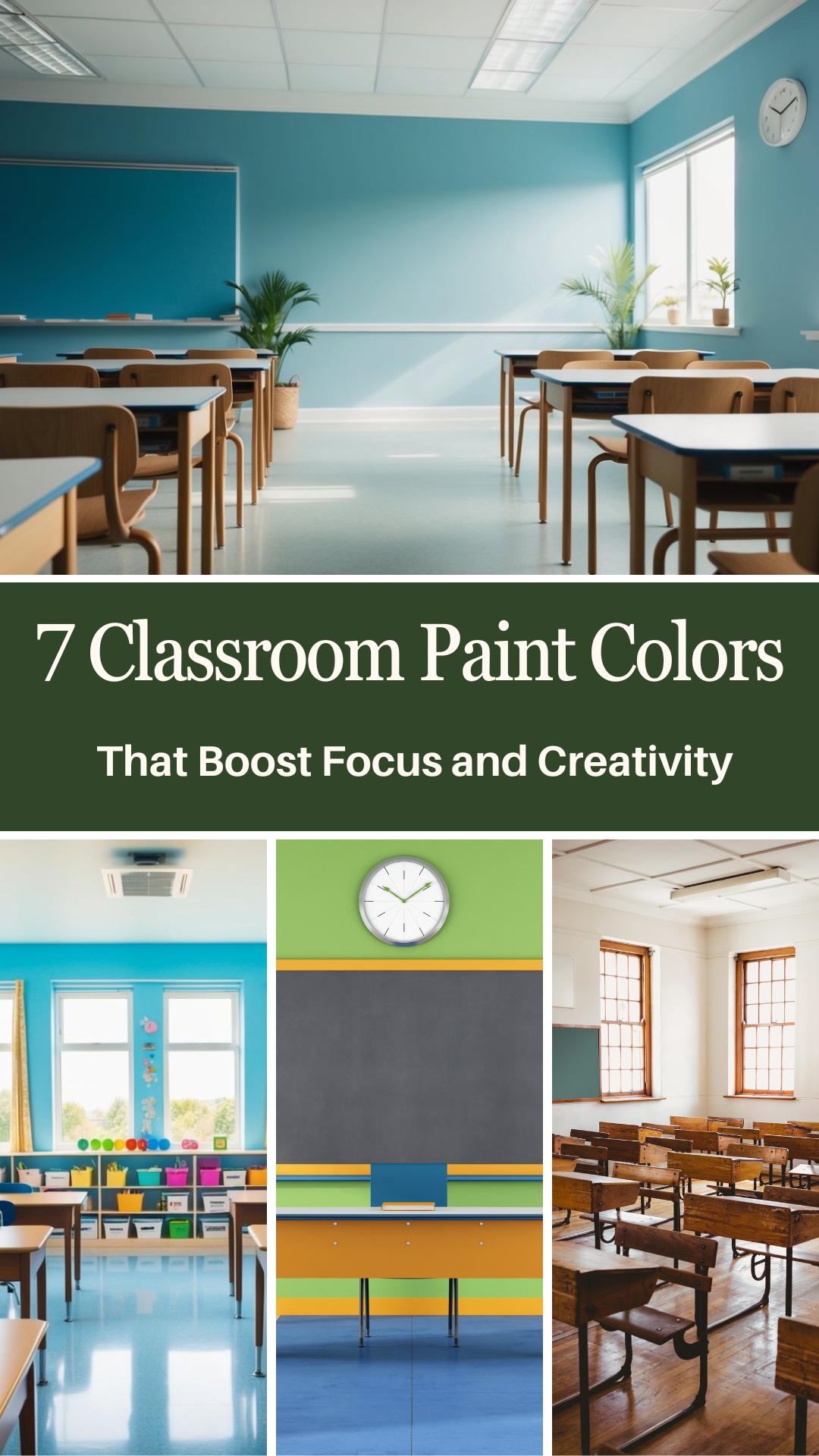7 Best Paint Colors for a Classroom: Boost Learning and Focus
Have you ever wondered how the color of your classroom walls could influence the way students learn? It turns out, the right shade can make a big difference in creating a welcoming and effective learning space. Colors can impact mood, focus, and even energy levels.

Choosing the best paint colors for your classroom can help foster a positive learning environment. From boosting memory and creativity to providing a sense of calm, selecting the right colors is essential. Let’s explore the top paint colors that can transform your classroom into an inspiring and productive place for your students.
Get the Fail-Safe Paint Color Playbook (Free PDF)
36 proven colors • 8 ready palettes • trim & sheen guide • printable testing cards.
1. Calm Cloud Blue

Calm Cloud Blue can be a perfect color for your classroom. It has a calming effect on students, helping them to feel relaxed and focused. Imagine walking into a room painted in soft pastel blue; it immediately puts you at ease.
Blue helps in reducing heart rates and lowering stress, making it great for an educational setting. Studies show that blue can enhance memory and boost creativity, perfect for young minds.
Using Calm Cloud Blue in the main entry of your school or on the exterior can create a welcoming environment. This shade is not too bright, preventing distraction, and not too dull, keeping the space cheerful and inviting.
This color is especially good for rooms where you need students to concentrate, like libraries or study areas. With Calm Cloud Blue, you can foster a peaceful and productive learning atmosphere.
2. Sunny Day Yellow
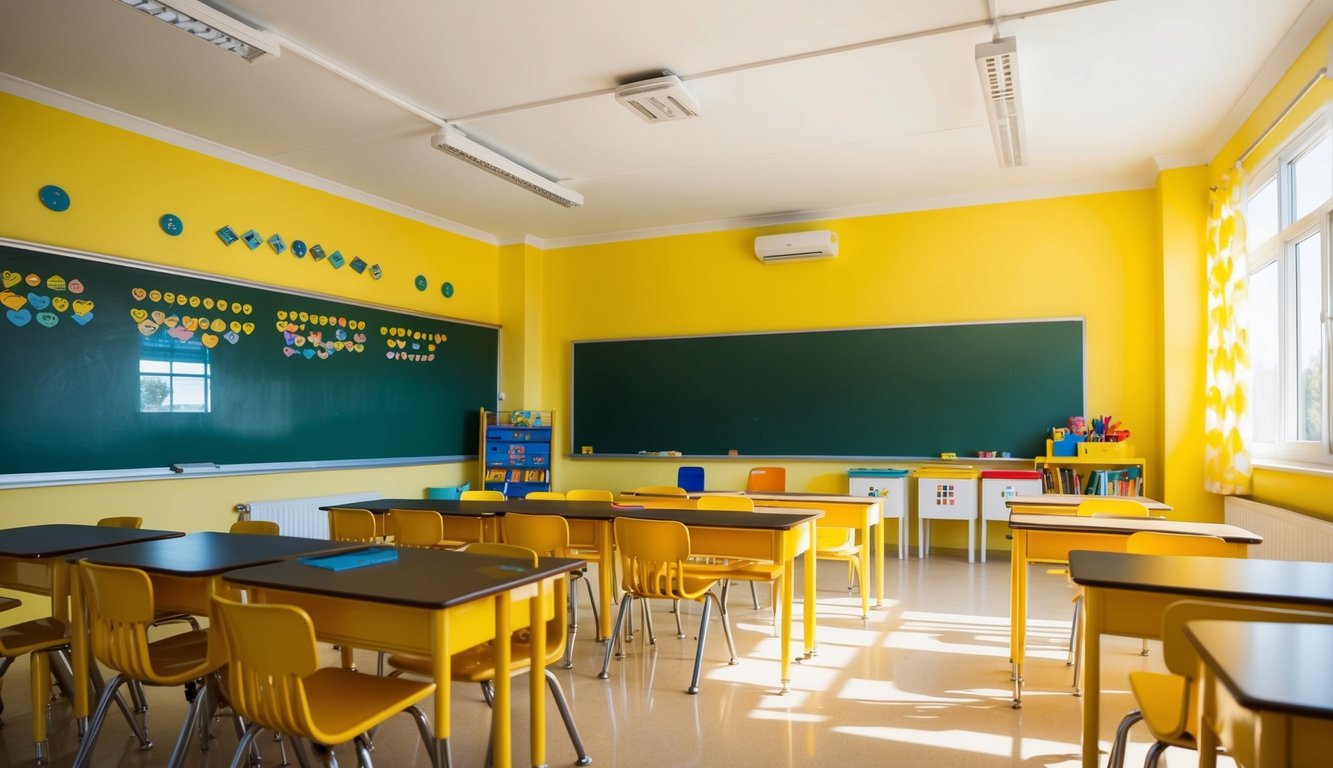
Sunny Day Yellow is a bright and invigorating color. It’s perfect for classrooms because it makes students feel energized and cheerful. Imagine walking into a room painted in this lively hue—it can lift your spirits instantly!
Yellow is also known to stimulate thinking and creativity. When students are exposed to this color, it can help them focus better. This makes it ideal for spaces where kids need to concentrate, like study areas.
In addition to classrooms, Sunny Day Yellow works well in dining areas. A cheerful yellow can make snack time more enjoyable. It’s like bringing a bit of sunshine indoors!
With a sunny yellow shade, walls can encourage happiness and even reduce anxiety. This is supported by sources such as HGTV and Dezeen. So, if you’re looking to brighten up your classroom, consider Sunny Day Yellow!
3. Bright Mind Green
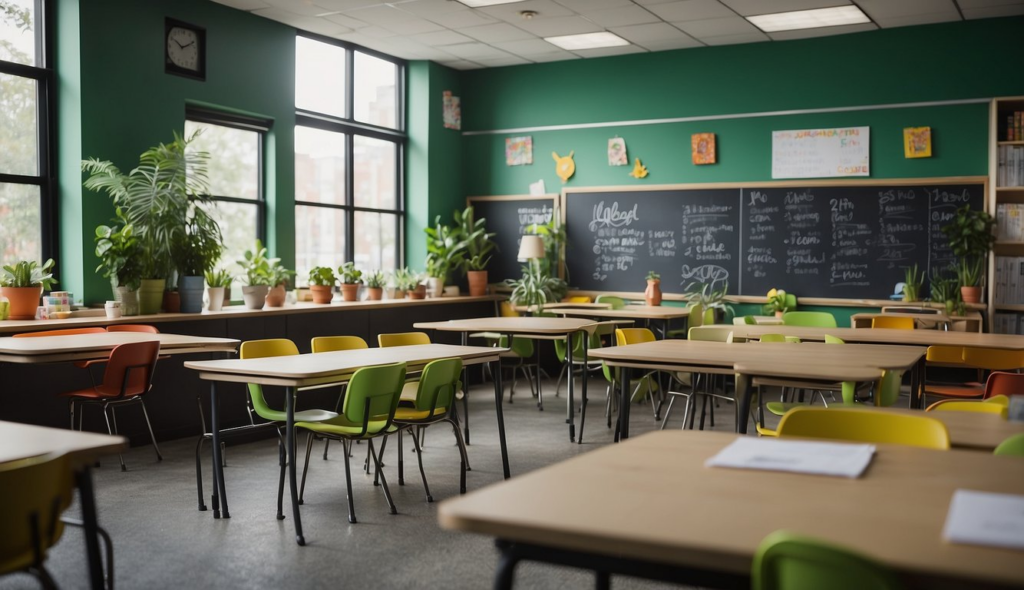
Green is a fantastic choice for a classroom. This color can help students feel calm and focused. Imagine walking into a room painted in a soft, soothing green. It feels like a breath of fresh air, right?
Studies say green can reduce anxiety. That’s great news for students who might feel stressed at school. Light green shades are especially effective. They are easy on the eyes and can create a tranquil environment.
Green is also said to boost creativity. This can be really helpful during art class or creative writing. If you’re looking for a color that helps balance relaxation with creativity, Bright Mind Green might just be it.
So, when choosing paint for your classroom, consider green. It’s not just a color; it’s a tool to help students thrive.
4. Creative Coral
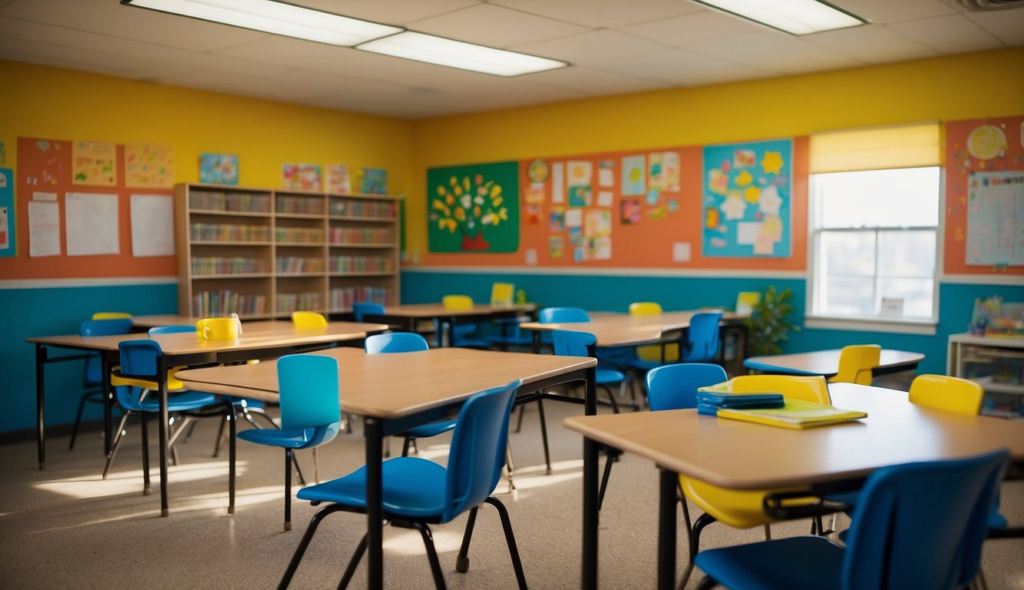
Coral is a fantastic choice if you want to bring warmth and energy into a classroom. This color combines pink and orange tones, creating a cozy, cheerful atmosphere. It’s like bringing a splash of sunshine indoors.
Get the Fail-Safe Paint Color Playbook (Free PDF)
36 proven colors • 8 ready palettes • trim & sheen guide • printable testing cards.
The soft, pastel shade of Benjamin Moore’s Sunlit Coral is perfect. This shade works well in many different rooms, from reading nooks to art stations.
Fading Terracotta from Farrow & Ball is another great option. It adds a warm and sun-soaked feeling to your space. You might feel like you’re in a beachside bungalow rather than a classroom.
Coral can also enhance creativity. It helps stimulate the mind, making it a great color for areas where students need to be imaginative. Paint a wall in coral, and watch how it brightens the entire area.
Why not try adding some coral accents? You can pair coral walls with neutral furniture to keep the space balanced and welcoming.
5. Energetic Orange
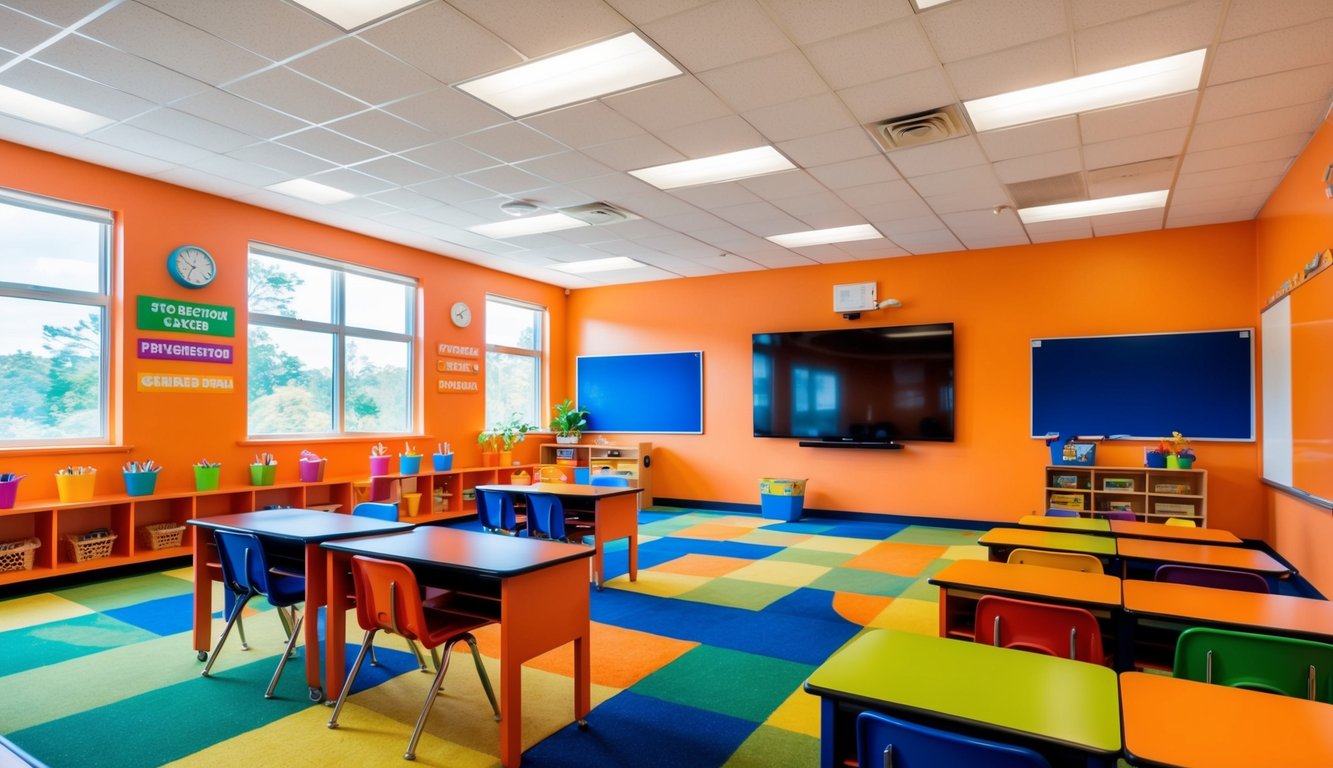
Imagine walking into a classroom filled with vibrant orange accents. Orange promotes energy and excitement. It’s a color that can help students feel more alert and ready to learn.
Using too much orange can be overwhelming. Instead, try splashes of orange in furniture or decorations. This keeps the space lively without being too intense.
Orange can also increase creativity. Students may find it easier to think outside the box when surrounded by this stimulating color. It’s great for areas where you want kids to brainstorm or collaborate.
Incorporating orange into your classroom is simple. You can paint a single wall, add orange chairs, or use orange bulletin boards. Making small changes can have a big impact on the room’s atmosphere.
6. Focus Field Green
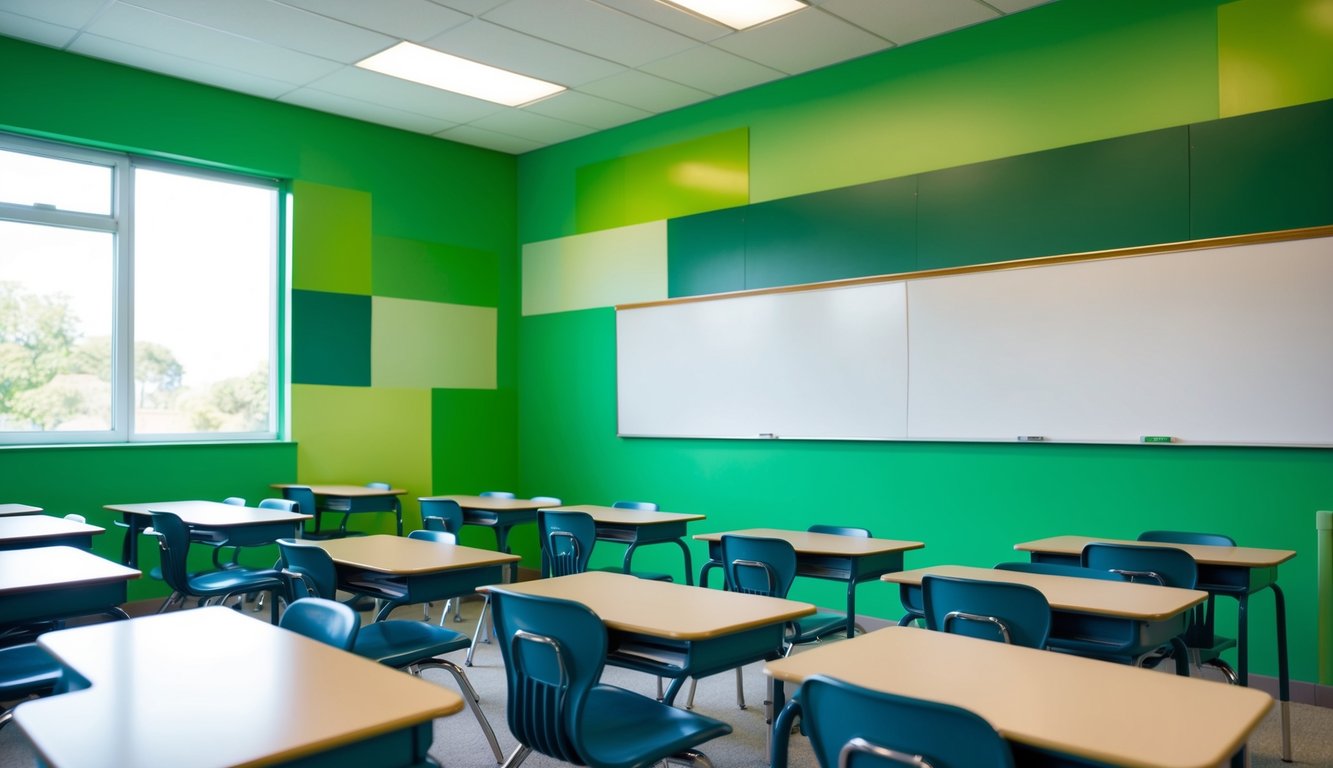
Have you ever noticed how green fields make you feel calm and focused? That’s the magic of Focus Field Green in classrooms.
This shade of green helps create a relaxed environment. When students feel calm, they can concentrate better. Studies show colors like green can lower stress.
Focus Field Green isn’t too bright or too dark. It’s just right for balance. Your classroom will feel lively but not overwhelming.
Get the Fail-Safe Paint Color Playbook (Free PDF)
36 proven colors • 8 ready palettes • trim & sheen guide • printable testing cards.
Teachers often choose this color for reading corners. It’s perfect for activities that need focus and tranquility.
7. Smart Sky Blue
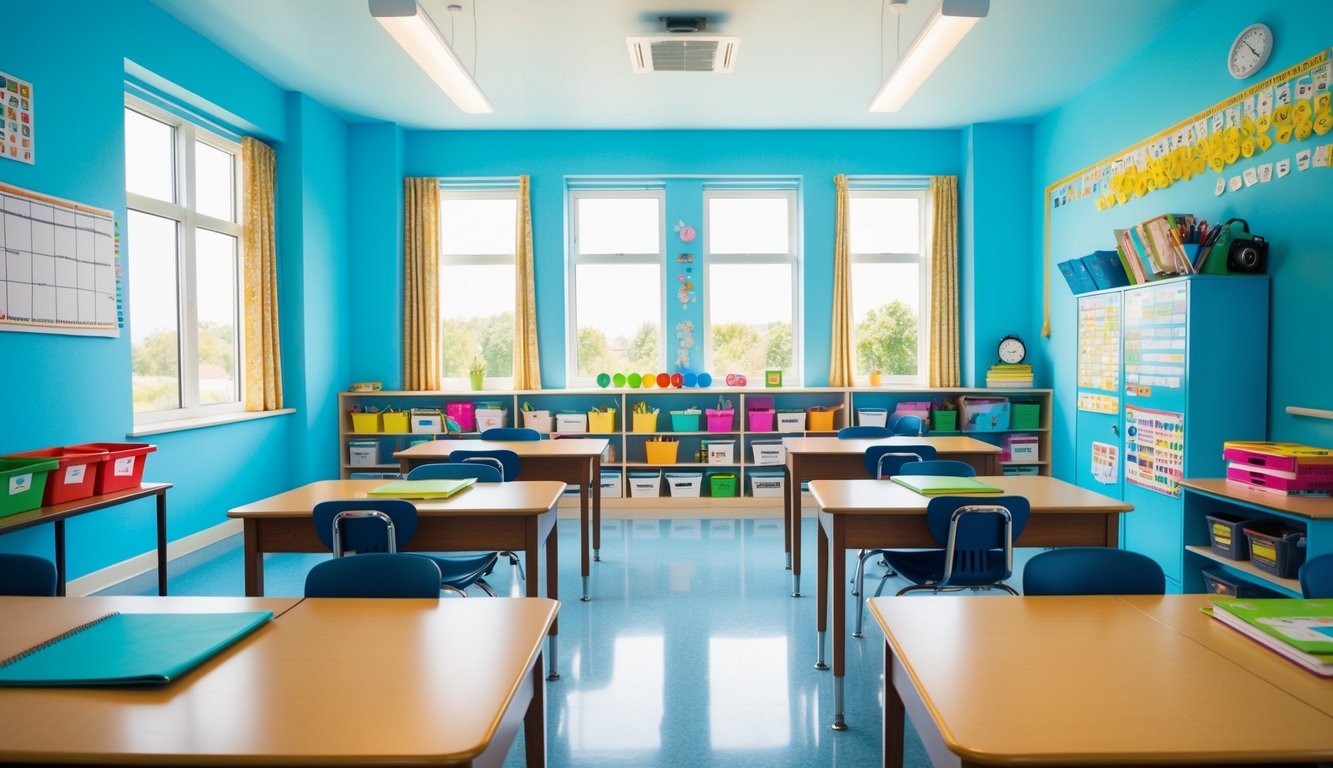
Using Smart Sky Blue in your classroom can be a smart choice. This light blue shade has a calming effect that helps students focus better. It’s not too bright, so it won’t overstimulate the kids.
Blue is known to boost productivity and reduce stress. Think about a clear sky or calm ocean; it’s soothing, right? Classrooms painted in Smart Sky Blue often have a peaceful atmosphere, which can be perfect for activities that need concentration.
Ever notice how blue is used in many tech companies’ logos? That’s because it promotes trust and clarity. Similarly, a classroom with blue walls can help students feel more relaxed and ready to learn.
It’s also recommended to pair Smart Sky Blue with white or neutral accents. This creates a balanced look that’s easy on the eyes. So, if you’re looking for a color that supports learning and calmness, Smart Sky Blue should be at the top of your list.
The Psychology of Classroom Colors
Colors can significantly impact students’ emotions and focus. Knowing how different colors affect moods and choosing the right shades for different age groups can create a positive and productive learning environment.
How Colors Affect Students’ Mood And Behavior
Colors influence how students feel and behave in the classroom. For instance, yellow can release serotonin in the brain, which may reduce anxiety and depression. This color also fosters creativity and optimism.
Green is another important color, promoting balance and growth. It offers a calming effect, ideal for classroom settings. Blue and green hues can be soothing and enhance concentration.
Get the Fail-Safe Paint Color Playbook (Free PDF)
36 proven colors • 8 ready palettes • trim & sheen guide • printable testing cards.
Warm colors like red and orange can stimulate energy and excitement, but should be used sparingly as they may also cause restlessness. Cool colors such as blue and green create a peaceful environment, encouraging better focus and relaxation.
Get the Fail-Safe Paint Color Playbook (Free PDF)
36 proven colors • 8 ready palettes • trim & sheen guide • printable testing cards.
Choosing The Right Color Based On Age Group
Different age groups respond uniquely to colors. For younger children, bright colors like yellow can make classrooms feel lively and cheerful, enhancing their overall happiness and engagement.
Elementary students benefit from green hues, which support balance and are calming. This can help them feel more comfortable and focused.
For teenagers, cooler tones like soft blues and greens are effective. These colors can help reduce stress and create a relaxing atmosphere, making it easier for them to concentrate during study sessions.
In spaces where high energy is needed, such as athletic or arts rooms, colors like red or orange can boost energy levels and enthusiasm. However, it’s crucial to balance vibrant colors with calming shades to prevent overstimulation.
Implementing Colors for Different Classroom Activities
Choosing the right colors can enhance different classroom activities. Let’s explore how specific colors can be used to improve creativity, focus, and collaboration in the classroom.
Colors for Creative Arts and Crafts
When it comes to arts and crafts, you want colors that inspire creativity and joy. Bright colors like yellow and orange are perfect because they are uplifting and energizing.
Yellow is associated with happiness and can stimulate both the mind and emotions. It’s great for boosting self-expression and creativity. Orange is another vibrant choice that can spark enthusiasm and encourage a positive attitude toward creative tasks.
You can use these colors on walls, art supply storage, and even in the artwork itself. Mix in some red for an extra boost of excitement and energy to get those creative juices flowing.
Colors for Focus and Concentration
For tasks that require focus and concentration, cool colors are your best bet. Cool tones like blue and green can create a calm and serene environment.
Blue is known for its ability to enhance concentration and lower stress levels. It’s particularly good for reading areas or desks where students need to focus on their work. Green, which symbolizes balance and growth, is also ideal. It reduces anxiety and helps maintain a peaceful atmosphere, making it great for study corners or quiet zones.
Consider using these colors for wall paints, bulletin boards, and other areas where students engage in focused activities.
Colors for Collaborative Spaces
Collaboration is key in any classroom, and the right colors can help foster teamwork and interaction. Warm colors like red and orange can stimulate conversation and engagement.
Red can increase energy levels and make students more alert, which is perfect for group discussions and interactive activities. Orange can enhance social interaction, making it easier for students to communicate and collaborate.
You might use these colors in group seating areas, project tables, or any space where teamwork is encouraged. Just be mindful to balance these vibrant colors with some neutrals to avoid overstimulation.
Maintaining and Updating Classroom Colors
Keeping your classroom paint looking fresh and appealing helps create a positive learning environment. Here are some tips on how to maintain and update your classroom colors effectively without breaking the bank.
Tips For Easy Maintenance
Regular cleaning helps keep classroom walls looking new. Dusting the walls once a week and wiping them with a damp cloth can prevent dirt buildup. Use mild detergents to clean any tougher stains or marks.
Touch up the paint as needed. Keep a small can of the original paint color for quick touch-ups whenever you notice scratches or chips. This can extend the life of your paint job.
Consider using washable paint. These paints are designed to withstand frequent cleaning and are ideal for high-traffic areas in classrooms. Investing in quality paint initially can save both time and money in the long run.
Get the Fail-Safe Paint Color Playbook (Free PDF)
36 proven colors • 8 ready palettes • trim & sheen guide • printable testing cards.
Encourage students to keep the walls clean. You can create a classroom culture that respects the space by rewarding students for keeping their area tidy. This small step can go a long way in maintaining the look of the classroom.
When and How To Update
Repaint every few years. A fresh coat of paint can make the room feel new and inviting. Reviewing the condition of your classroom walls at the end of each school year can help you decide if it’s time for a repaint.
Change colors based on needs. If you notice that students are not as focused as you’d like, try changing the colors. For instance, blue can help with concentration while yellow can boost creativity. Adapting colors to your students’ educational demands can make a big difference.
Use a color scheme that evolves. Initiating a gradual change rather than a complete overhaul can be less disruptive and more cost-effective. For instance, updating one wall at a time or adding new shades can refresh the look without requiring a full repaint.
Consult with professionals. Sometimes it’s worth getting advice from a paint professional or interior designer who specializes in educational environments. They can offer insights into the best types of paints and color schemes suited for learning spaces.
